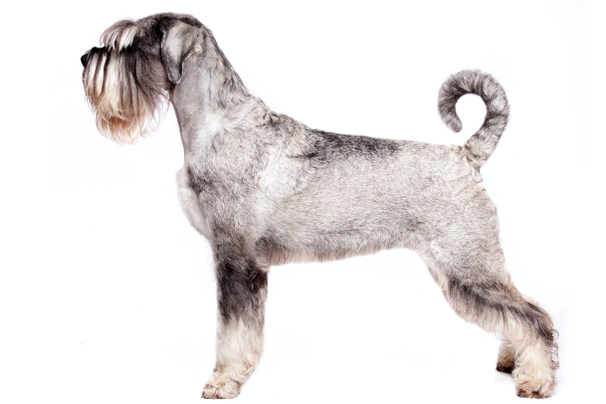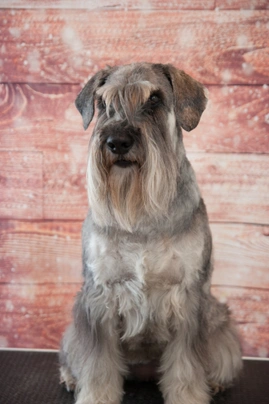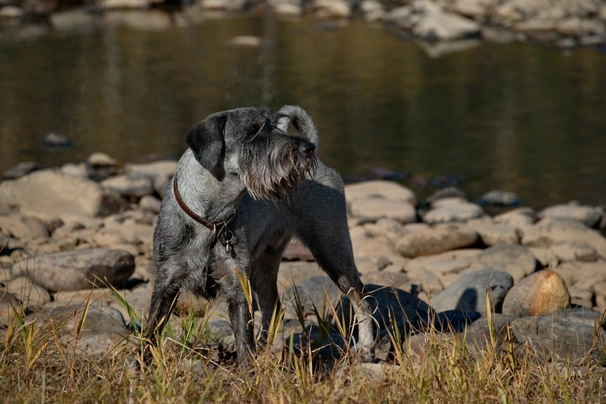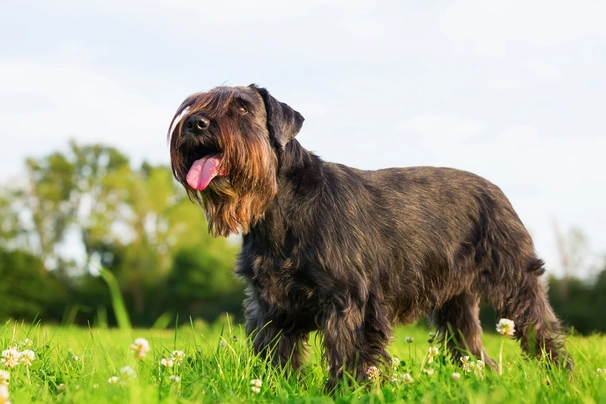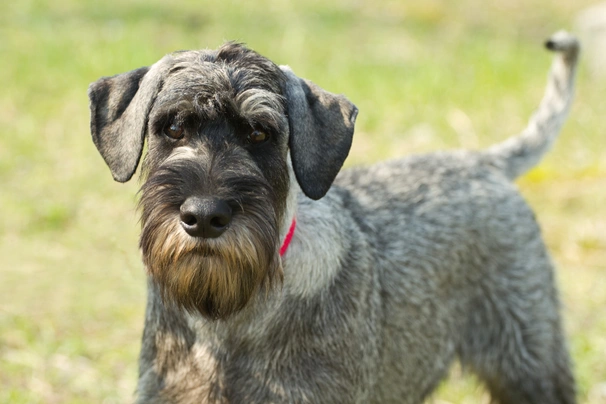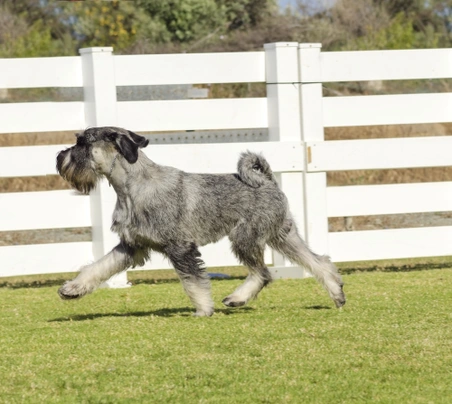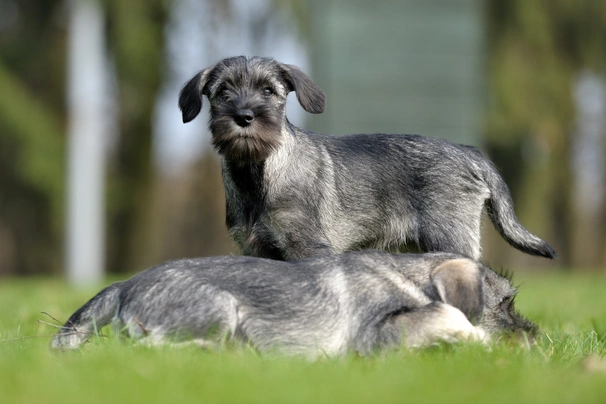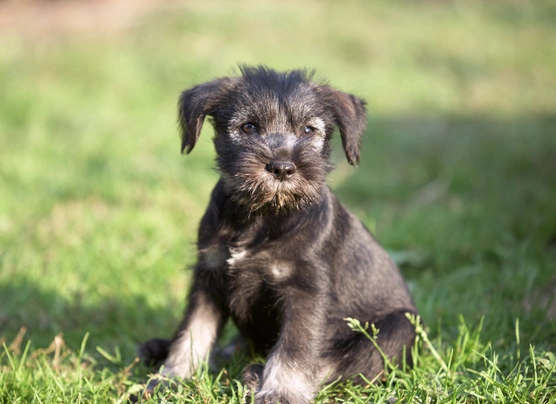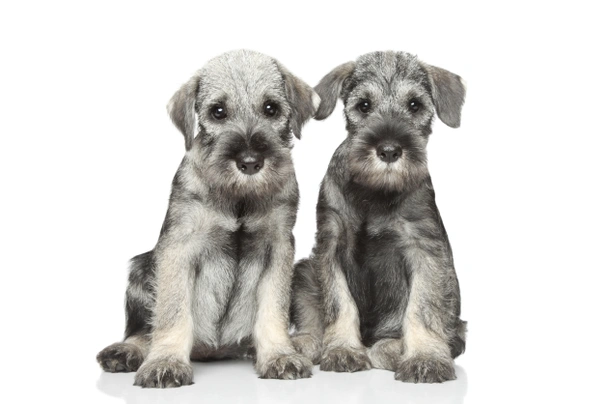Schnauzer
Introduction of the Schnauzer
The Schnauzer is a medium sized dog being larger than the Miniature and that much smaller than the Giant Schnauzer. In the States they are known as Standard Schnauzers and these charming dogs have become a popular companion and family pet on both sides of the Atlantic as well as elsewhere in the world. These lovely looking dogs have found their way into the hearts and homes of many people for many good reasons because the Schnauzer is a charming dog that boasts an even and kind nature which makes them such wonderful pets to have around.
History of the Schnauzer
The Schnauzer was originally bred to work as a ratter in their native Germany. They were also used to drive livestock and to guard properties and stables all of which were jobs they excelled at. Some dogs were even used to pull carts which made them very good all-round working farm dogs. The breed has been around since the 15th century with dogs appearing in a well-known tapestry by Lucas Cranach the Elder. They have also been depicted by Old Masters with Rembrandt being one of the artists who painted Schnauzers in his work.
These charming dogs have always been highly prized in Germany not only for their working abilities but also because they have always been good companions and family pets. The breed was standardised during the mid-1800's when breeders introduced grey Wolfspitz and black German Poodles into the mix. They were originally called Wirehaired Pinschers and were first exhibited at a dog show in Hanover in 1879. A breed standard was established the following year in 1880.
It was only at the beginning of the nineteen hundreds that they became known as the Schnauzer which is thought to be due to the breed's rather unique looking muzzle – which in German is "schnauze" and because of the first dog to win first prize in the show ring having been called Schnauzer. In 1907. The Bavarian Schnauzer Klub was formed in Munich and the breeds popularity grew and grew throughout the world from there on in.
Today the Schnauzer is among one of the most popular breeds around thanks to their charming looks and the fact they boast such kind affectionate and loyal natures. As such they have found their way into the hearts and homes of people throughout the world including here in the UK.
Appearance of the Schnauzer
Height at the withers: Males 47 - 50 cm Females 44 - 47 cm
Average weight: Males 16 - 23 kg Females 16 - 23 kg
The Schnauzer is a robust compact well-muscled dog that boasts a wiry harsh coat and very distinctive head which is strong and moderately broad between a dog's ears. They have flat foreheads nicely muscled cheeks and moderate stops that accentuate the shape of their eyebrows. Muzzles are strong and end bluntly with dogs having stubby moustaches and whiskers. The ridge of their noses is almost level with their foreheads and their noses are black in colour having wide nostrils.
Their eyes are medium in size and oval shaped being dark in colour. Schnauzers have heavy arched eyebrows that adds to their overall charming appeal. They have V-shaped ears set high on their heads and which fall forwards on a dog's temple. They have a strong jaw with a perfect scissor bite where their upper teeth neatly overlap their lower ones.
Their necks are moderately long and a little arched sitting cleanly on a dog's shoulders which are well laid and flat. Front legs are straight well-muscled showing a good amount of bone. They have compact sturdy bodies with moderately broad chests and a visible breastbone. Their backs are straight and strong being a little higher at the withers than at a dog's hindquarters. Loins are nicely developed and short with Schnauzers having well sprung ribs.
They have strong hindquarters with well-muscled thighs and powerful well developed back legs. They have very cat-like feet being short round and compact with tightly arched toes firm black paw pads and dark nails. Tails are moderately long adding to a dog's overall balance and set high with dogs carrying them as straight as possible and jauntily when excited. Tails are thicker at the root but taper to the tip.
When it comes to their coat the Schnauzer boasts having a wiry harsh and short top coat with the hair on their necks and shoulders lying closer than on the rest of their bodies. The hair on their legs is harsher to the touch. The undercoat is dense and much softer. The accepted breed colours are as follows:
- Pure black
- Pepper and salt - ranging from dark iron grey to a light grey
A Schnauzer's facial mask should match their coat colour.
Temperament of the Schnauzer
The Schnauzer is a highly intelligent reliable dog and one that boasts a tremendous amount of stamina. They are always alert and ready to go which is one of the reasons they are such good companions to have around. They are known to have a bit of a stubborn streak in them which is why their training has to start early and it has to be consistent and always fair so that a dog understands what is expected of them. Schnauzers need to be handled with a firm yet gentle hand so they understand who is boss. They are never happier than when they know who they can look to for direction and guidance. If they don't know who is the alpha dog in a household they may quickly take on the role of a dominant dog which can make them harder to live with and handle.
The need to protect is deeply embedded in their psyche which can see dogs becoming a little too protective of things which includes the children. As such this particular trait has to be gently curbed when dogs are still young. They tend to be rather wary and suspicious of strangers which is another trait that makes them such good watch dogs. However rarely would a Schnauzer show any sort of aggression towards people they don't know preferring to keep their distance and let their owners know that someone is around.
They are energetic and athletic dogs and as such they need to be given a lot of mental stimulation on a daily basis to prevent boredom setting in. Gardens need to be ultra-secure with high fences because Schnauzers are very good escape artists and will jump a fence if the mood takes them.
It's really important for these dogs to be well socialised from a young age so they grow up to be confident outgoing mature dogs. Their socialisation has to include introducing dogs to lots of new situations noises people other animals and dogs once they have been fully vaccinated. A great way of starting their education in earnest is to enrol a Schnauzer into puppy classes. Not only is this a great way of socialising a dog but it also means their training can be carried out in a safe and controlled environment.
Intelligence / Trainability of the Schnauzer
The Schnauzer is a very smart dog and a fast learner. The downside to this is they are just as quick to pick up bad habits as they are the good. They need to be well socialised from a young age but their training has to begin early too. It also has to be very consistent and always fair so that a dog understands what their owner expects of them. Schnauzers are never happier than when they are given something to do which is why they are so amenable to learning new things. However they can be a little stubborn at times which means they need to be handled with a firm yet gentle hand so they understand who is the alpha dog.
The key to successfully training a Schnauzer is to make their training as interesting as possible and to avoid too much repetition. It's also a good idea to keep training sessions that much shorter which helps keep a dog more focussed on what they are being asked to do bearing in mind that the more intelligent a dog is the faster they get bored. They are sensitive dogs and as such they do not answer well to harsh correction or heavier handed training methods. They do respond well to positive reinforcement which always brings the best out of these clever quick witted dogs.
Children and other
Schnauzers are known to be very good around children thanks to their gentle placid natures. However because of their size any interaction between toddlers and a dog should always be well supervised by an adult to make sure playtime does not get too boisterous which could end up with someone being knocked over and hurt.
When dogs have been well socialised from a young enough age they generally get on well with other dogs they meet and if they have grown up with a family cat in a household they usually get on well together. However a Schnauzer would think nothing of chasing off any other cats they encounter because they would see them as fair game. Care has to be taken when they are around any smaller animals and pets because of their high prey drive as such any contact is best avoided.
Health of the Schnauzer
The average life expectancy of a Schnauzer is between 13 and 16 years when properly cared for and fed an appropriate good quality diet to suit their ages.
The Schnauzer is known to suffer from a few hereditary health issues which are worth knowing about if you are planning share your home with one of these active and good looking dogs. The conditions that seem to affect the breed the most include the following:
- Hip dysplasia
- Pulmonic stenosis(Congenital heart problem)
- Nephroliths
- Skin allergies
- Schnauzer Comedone Syndrome
- Fatty tumours
- Adenomas
Caring for the Schnauzer
As with any other breed Schnauzers need to be groomed on a regular basis to make sure their coats and skin are kept in top condition. They also need to be given regular daily exercise to ensure they remain fit and healthy. On top of this dogs need to be fed good quality food that meets all their nutritional needs throughout their lives.
Grooming of the Schnauzer
When it comes to grooming the Standard Schnauzer is a pretty high-maintenance because their coats need regular trimming. Ideally their coats should be hand-stripped several times a year which makes keeping things tidy that much easier in between visits to a grooming parlour. Their coats need to be brushed twice weekly to keep things nice and tidy.
They shed very little throughout the year but it can be more during the Spring and then again in the Autumn when more frequent grooming is usually necessary to stay on top of things and to remove dead and shed hair from a dog's coat. It's also important to check a dog's ears on a regular basis and to clean them when necessary. If too much wax is allowed to build up in a dog's ears it can lead to a painful infection which can be hard to clear up. In short prevention is often easier than cure when it comes to ear infections.
Exercise of the Schnauzer
The Schnauzer is a high energy intelligent dog and as such they need to be given the right amount of daily exercise and mental stimulation for them to be truly happy well-rounded dogs. They need a minimum of 60 minutes exercise a day with as much off the lead time as possible. If they are not given the right amount of mental stimulation and exercise every day a Schnauzer would quickly get bored and could even begin to show some destructive behaviours around the home which is their way of relieving any stress they are feeling and not necessarily because they are being naughty.
A shorter walk in the morning would be fine but a longer more interesting one in the afternoon is a must with as much off the lead time as possible. These dogs also like to be able to roam around a back garden as often as possible so they can really let off steam. However the fencing has to be extremely secure to keep these high energy dogs in because if they find a weakness in the fence they will soon escape and could get into all sorts of trouble bearing in mind that Schnauzers are very good escape artists and they can jump fences with no trouble at all when the mood takes them.
With this said Schnauzer puppies should not be over exercised because their joints and bones are still growing. This includes not letting a dog jump up and down from furniture or going up or down the stairs. Too much pressure placed on their joints and spines at an early age could result in a dog developing serious problems later in their lives.
Feeding of the Schnauzer
If you get a Schnauzer puppy from a breeder they would give you a feeding schedule and it's important to stick to the same routine feeding the same puppy food to avoid any tummy upsets. You can change a puppy's diet but this needs to be done very gradually always making sure they don't develop any digestive upsets and if they do it's best to put them back on their original diet and to discuss things with the vet before attempting to change it again.
Older dogs are not known to be fussy eaters but this does not mean they can be given a lower quality diet. It's best to feed a mature dog twice a day once in the morning and then again in the evening making sure it's good quality food that meets all their nutritional requirements. It's also important that dogs be given the right amount of exercise so they burn off any excess calories or they might gain too much weight which can lead to all sorts of health issues. Obesity can shorten a dog's life by several years so it's important to keep an eye on their waistline from the word go.
Schnauzer price
If you are looking to buy a Schnauzer you would need to pay anything from £300 to over £500 for a well-bred pedigree puppy. The cost of insuring a male 3-year-old Schnauzer in northern England would be £22.55 a month for basic cover but for a lifetime policy this would set you back £41.75 a month (quote as of July 2016). When insurance companies calculate a pet's premium they factor in several things which includes where you live in the UK a dog's age and whether or not they have been neutered or spayed among other things.
When it comes to food costs you need to buy the best quality food whether wet or dry making sure it suits the different stages of a dog’s life. This would set you back between £30 - £40 a month. On top of all of this you need to factor in veterinary costs if you want to share your home with a Schnauzer and this includes their initial vaccinations their annual boosters the cost of neutering or spaying a dog when the time is right and their yearly health checks all of which quickly adds up to over £900 a year.
As a rough guide the average cost to keep and care for a Schnauzer would be between £60 to £90 a month depending on the level of insurance cover you opt to buy for your dog but this does not include the initial cost of buying a pedigree or other puppy.

BEAUTIFUL GIRL
£1,250
Gorgeous Standard Schnauzer Puppies !
£1,600

